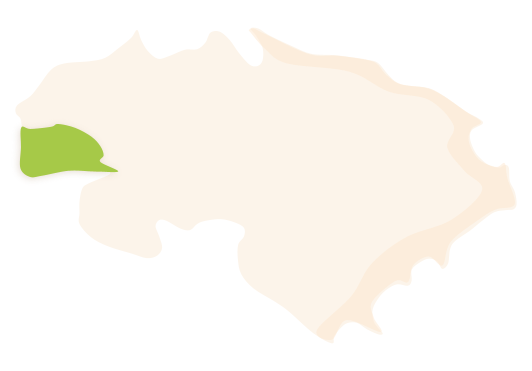The valley known as La Vall d'Alcalà, situated at the northern end of the region, borders the Comtat region and is where the source of the Girona River is located. It is made up of two small villages, Alcalà de la Jovada and Beniaia, and the valley is one of the four valleys called Les Valls de La Marina. Located 637 metres above sea level and with an area of 24.2 km2, currently it has a population of 163 inhabitants who are called Alcalaners and Alcalaneres.
 La Vall d'Alcalà's municipal district. Surface area: 24.2 km². Population: 163.
La Vall d'Alcalà's municipal district. Surface area: 24.2 km². Population: 163.HISTORY
It is a valley amongst valleys, framed to the north by the mountain range known as Serra Foradada and the valley known as La Vall de Gallinera, to the south by the last peaks of Serra de l'Alfaro and by La Vall de Seta, to the west by the Serra dels Llombos and Serra de Cantacuc mountain ranges and the valley called La Vall de Planes, and to the east by Serra del Cireret and La Vall d'Ebo. The whole of La Vall d'Alcalà is full of numerous ravines and slopes, providing it with a great wealth of water resources.
La Vall d'Alcalà preserves archaeological vestiges of human presence since prehistoric times. There are various sites which are good examples of this, such as: the ravine called El Barranquet de Beniaia and the rock shelter known as Tossal de La Roca, from the Palaeolithic period; the settlements of El Tossal de La Roca and Penya de La Retura, from the Bronze Age; the cave paintings of the Condoig and Barranc de La Gleda rock shelters; and the Iberian settlement of Xarpolar.
However, it was not until the Muslim era that this valley began to fill up with farmhouses, many of which remained abandoned after the expulsion of the Moors: L'Atzubieta, La Roca, Els Benialís, Benixarco, El Rafalet, and La Queirola, apart from La Jovada and Beniaia which are the two that have survived to this day.
To speak of Alcalà is to speak of Al-Azraq, the Moor chieftain who was born in Alcalà between 1218 and 1220, and was the one who dared to stand up to Jaume I's army, rising up in rebellion three times. According to the documents available, he had his main headquarters in Al-qa'la (“the castle”), located in the current municipal territory of La Vall de Gallinera, but which at that time was part of La Vall d'Alcalà together with Benissili, which is the last town of the current valley limits of La Vall de Gallinera.
After the Christian conquest, for more than three centuries it was inhabited by the same Muslim population, which maintained its own customs and religion, and even its own organisation until shortly before the expulsion, in 1609.
La Vall d'Alcalà was repopulated with a remarkable immigration from Ibi, followed by Majorcans and people from other Valencian areas. Within the valley, Beniaia was the preferred home of the islanders who left evidence of their presence with surnames such as Servera, Cortell, Malonda and Porcell.
The two ice houses preserved there are noteworthy and are clear evidence of the economy generated thanks to ice during the period known as the Small Valencian Ice Age.
These places, moreover, have been preserved in the Valencian collective memory through three of the fables collected by Enric Valor: L'envejós d'Alcalà, El derrer consell and Don Joan de la Panarra.
FESTIVITIES
- The Al-Azraq Festival, usually celebrated during the first week of July in Alcalà de La Jovada and during the third week of July in Beniaia, is a gastronomic market held with the participation of the association of the food service sector of La Vall d’Alcalà, with cultural activities included in the event.
- The festivity and bonfire of Saint Antoni, celebrated on the weekend closest to January 17th.
- The patronal festivities of Alcalà de la Jovada, held from August 7th to 14th.
- The patronal festivities of Beniaia, held during the third weekend of September.
GASTRONOMY
- Typical things are “minxos” (flour “coques” or flatbreads, with all kinds of accompaniments), “blat picat” (a stew with broken wheat grains) and rice with lentils.
- The most noteworthy desserts are honey cakes and the “mostatxuts”.